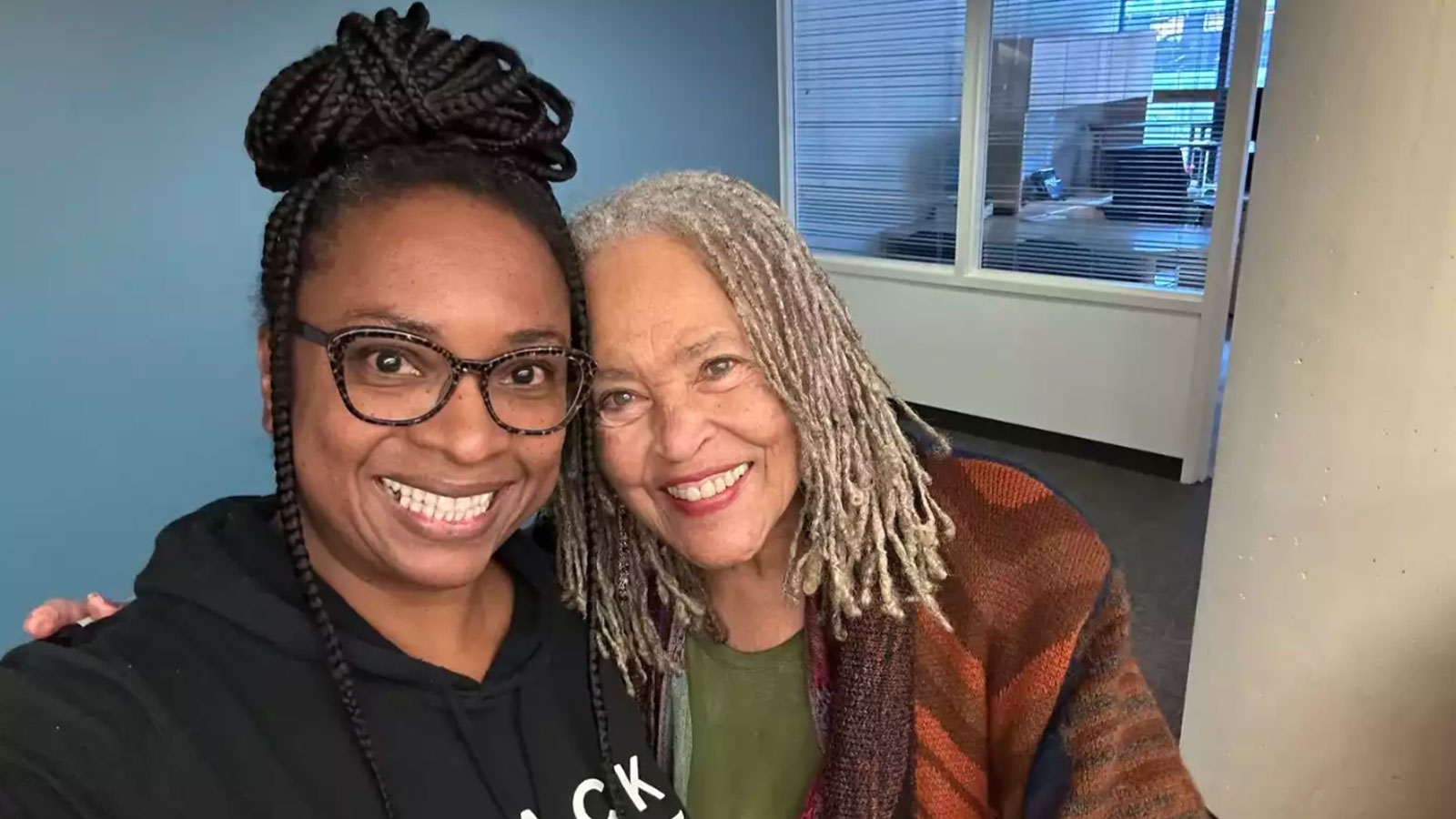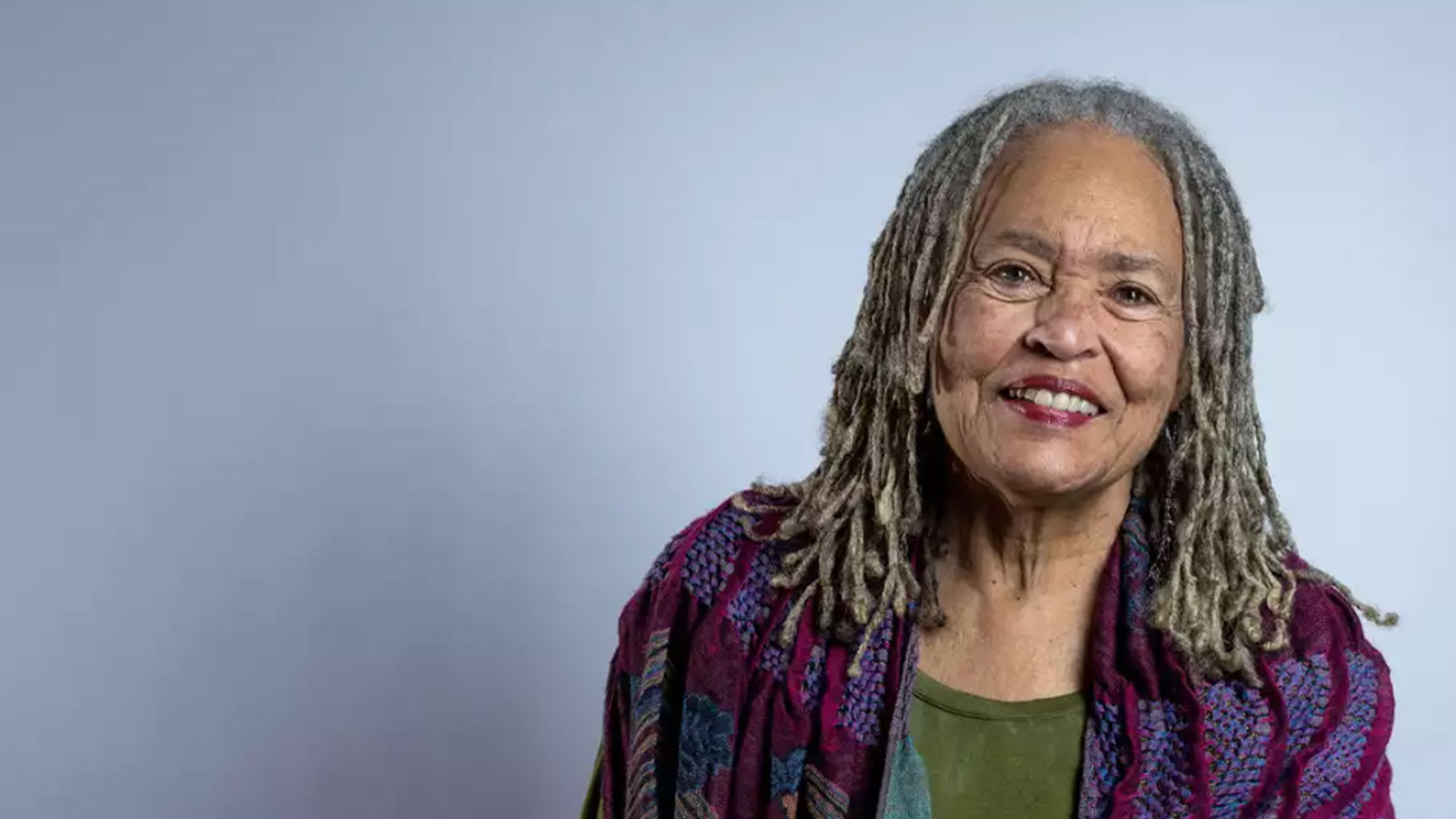Hunter-Gault talked to MPR News host Angela Davis about her latest book, her conversation with Nelson Mandela, how she made history and why Black history needs to be told.
By Angela Davis and Nicole Johnson, MPR News —
Charlayne Hunter-Gault is a longtime journalist who worked as a reporter for The New York Times, PBS, NPR and CNN. She was one of the first Black journalists to hold high-profile positions in major newsrooms, paving the way for the next generation of journalists of color.
And before she even started her journalism career, she was already in the history books. She was one of two Black students who desegregated the University of Georgia in 1961.
Listen to a rebroadcast of a conversation MPR News host Angela Davis had in February with Hunter-Gault about her latest book, “My People: Five Decades of Writing About Black Lives.”

Angela Davis and Charlayne Hunter-Gault, two generations of empowered Black journalists, in the newsroom at MPR News in St. Paul on Feb. 17. (Angela Davis | MPR News)
Here are five key moments from the conversation.
The following transcript has been edited for length and clarity. Listen to the full conversation at MPR News
Sixty years ago, you were one of two Black students to enroll at the University of Georgia in its history. Tell us about your experience.
There was a group of aggressive Black men who felt that Georgia waited too long to get the Brown v. Board of Education decision tested. Brown v. Board was the decision in 1954 that outlawed segregated schools. These men implemented it. They came to our high school and asked the principal for two students who might be interested in going. Of course, with Hamilton Holmes and me being first and third in our high school class, they brought us in.
The best way to describe it is that we desegregated it, instead of integrating it. It took a while to integrate. Desegregate was saying: OK, Black people are here, but we can’t go to the same cafeteria. There were students gathering around the registration building, which is now named for Hamilton and me, by the way, yelling the n-word and ‘go home.’ Because of the background and training that I had, it didn’t bother me. When they would yell that I would ask myself who they were talking about because I was a queen, so they couldn’t be talking about me.
Your most recent publication is a book called “My People: Five Decades of Writing About Black Lives.” Who do you want to read it?
I want everybody who can read to read it, and if they have children who can’t read, read it to them. Because I think that it’s like the book I wrote about Africa. Africa for years was always reported on in terms of what I call the four Ds: death, disease, disaster and despair, and there’s more to the continent than that.
Not everybody in this book is Black. White people died for us in the civil rights movement. I remember when John Lewis, who was one of our great civil rights pioneers, took a bus to challenge the sacred desegregation of interstate bus routes. White people went with them, and before they left D.C., they all signed their wills, because they knew that they were undertaking a serious challenge. So while primarily it’s the history of Black people, for the most part, it’s the history of our people, who are my people.
Tell us about the conversation you had with Nelson Mandela, shortly before he was sworn in as president of South Africa, when you told him you couldn’t attend his swearing-in ceremony.
I apologized because he knew me from the years that I had covered the anti-apartheid struggle. But I was a mom with two younger children, one was eight years younger than the other one. I had very good people who looked after him, including their father, but I was away from them a lot.
At that time, my son was graduating from Emory University and I had to be there. So I said to Mandela: “I’m so happy to be here to interview you prior to you taking over as the first Black president of South Africa, but unfortunately, I’m not going to be able to be here,” and explained why. Then he looked at me with the most wonderful fatherly smile and he said: “Of course, you have to be there. You can interview me anytime.” And that was true. Anytime I wanted to interview Mandela, he would make time for me to do it. I got to Atlanta in time to see my son get his bachelor’s degree. As you know, because you are a mom, it’s a balancing act.
Your book emphasizes the importance of teaching young people Black history and how it has shaped who you are. What is it like for you to hear stories about the backlash to teaching Black history in schools?
I think that there are people out there who are fighting the backlash. It’s early. In some cases like in Florida, there’s one school that has been taken over by people who don’t want this history taught. You just have to continue to try to inform people about why Black history is important. And also, because it’s our armor. We learn from history. You look at the history, and then you just try to share that with people in a way that helps them work towards a more perfect union.
There are a lot of people who are unhappy with this attack on Black history and I’m hoping that they’re gonna step up and speak out to people who are opposing this teaching so that they can understand why it is important and, what it has meant to our country as a whole. Because in our history, we have people, even before Martin Luther King way, going way back to Frederick Douglass and so many others. They need that history.
What are the stories you remember about covering the end of apartheid?
You just go and talk to people, you get your feet in the street. I wrote about a young man, his name was George, but he was actually called Doctor Death on the day of his death. He helped us get through so much when we were in South Africa, leading us around to various places and helping us to know where to go to talk to former apartheid people. This is how you work with people no matter what color they are if they have the right attitudes.
When I returned to New York, where I was working then for PBS NewsHour, I learned he had been murdered. He was asked to help cover a story about Black people rioting with each other and when he went there, he was seen as the enemy because he was white, and they murdered him. So I wrote a piece called Doctor Death and that was published in the New Yorker. So I guess, as I talk, and I think about my own life, which I rarely do, I think it’s the people who have helped me continue on my path.
Source: MPR News
Featured image: Pioneering Black journalist and civil rights activist Charlayne Hunter-Gault outside an MPR News studio at the Kling Public Media Center in St. Paul on Feb. 17. (Ben Hovland | MPR News)















